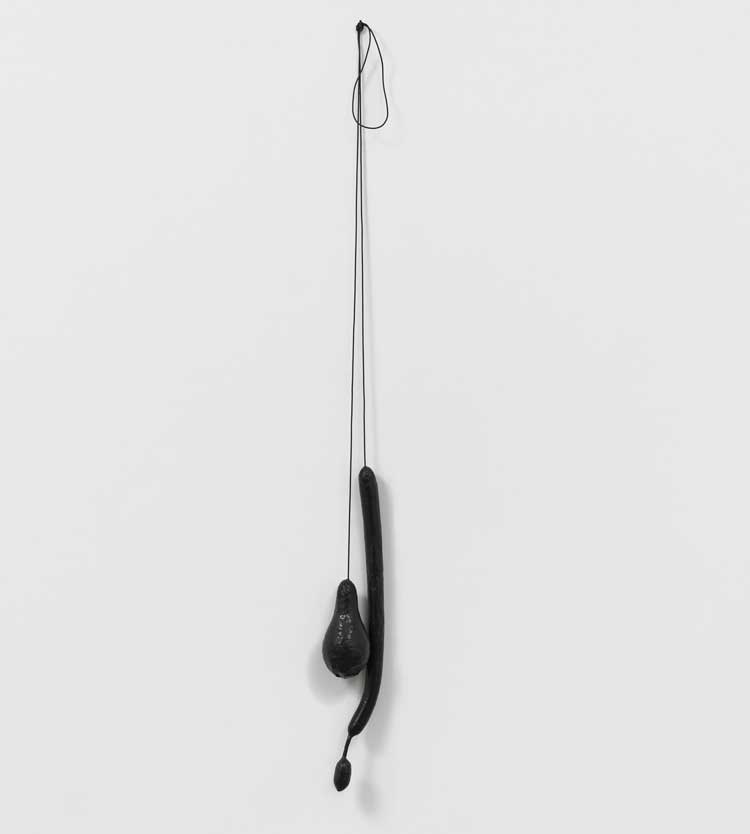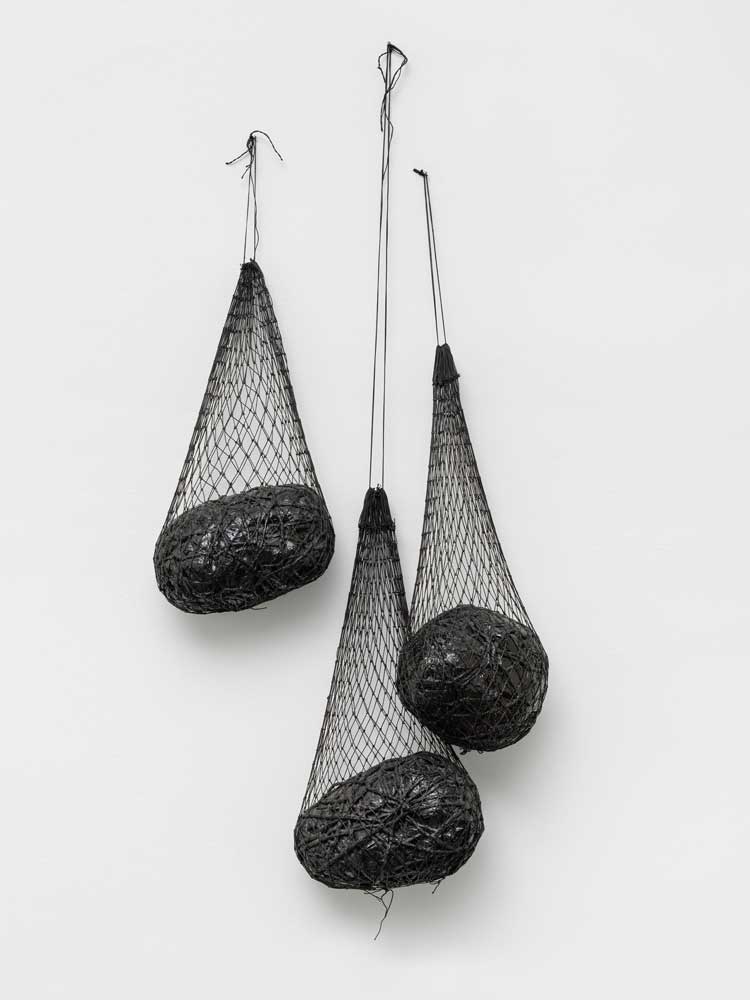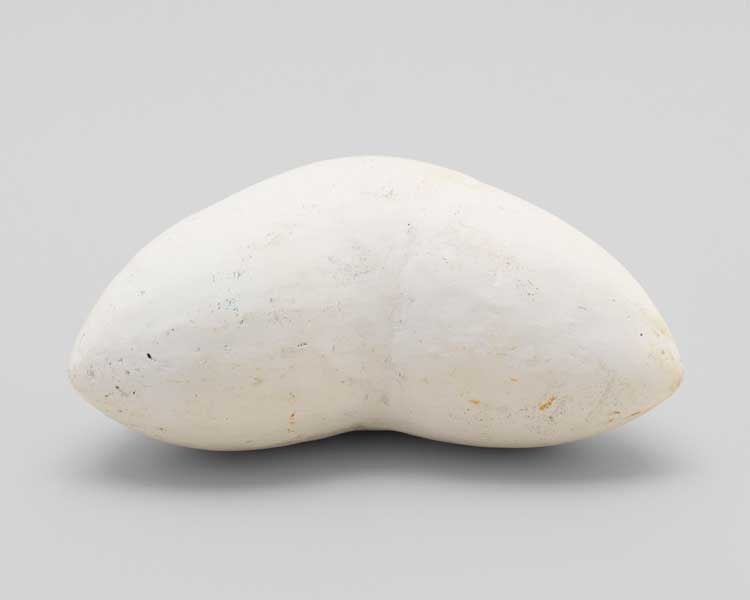
Alice Adams, Sheath, 1964. Cotton cord on cotton rope, 11.4 × 35.6 × 7.6 cm. Collection of Beth Rudin DeWoody. © Howcroft Photography, Boston.
The Courtauld Gallery, London
20 June – 14 September 2025
by BETH WILLIAMSON
Who knew that the 1960s New York art scene could be reinvigorated today in the Courtauld Gallery in London? Thanks to the vision of Dr Alexandra Gerstein and Professor Jo Applin, the September 1966 exhibition Eccentric Abstraction at the Fischbach Gallery in New York, curated by the critic Lucy Lippard, is brought back to life here. Sixty years on, it is easy to look back at this pivotal moment, an exhibition that broke new ground in respect of postwar American sculpture and, it turns out, launched the careers of many of the eight artists featured in that exhibition, three of whom were women. This new exhibition takes Lippard’s term “abstract erotic” as its reference point and shows the work of the three women – Louise Bourgeois (1911-2010), Eva Hesse (1936-70) and Alice Adams (b1930) – all working with new materials and developing a visual vocabulary unlike anything that had been seen before.

Alice Adams, Threaded Drain Plate, 1964. Steel cable through perforated drain plate, 47 × 20.3 × 26.7 cm, Zürcher Gallery, New York. Collection of Beth Rudin DeWoody. © Howcroft Photography, Boston.
As Applin points out, these three artists were not part of a movement or working together, but existed within the wider networked art scene where their friends and peers worked in various ways. This is how those making pop art, minimalist art and the sort of eccentric abstraction we see in this exhibition worked alongside and in dialogue with each other. These women were using new materials, thinking through making, finding a way through the minimalism that surrounded them. Often using industrial materials, they turned to the hardware stores, industrial supply stores and plumbers’ merchants of Canal Street in Lower Manhattan that became their artist’s supply stores.
In thinking about what was unique in these works, Lippard called them “abstract erotic” because of the sensuous experience of materials, their bodily nature, their fleshiness, their tactility. What was clear to Lippard, and what is obvious in this exhibition, is that the erotic was not just about objects that were obviously erotic in their references, but also the ugly and the abject. What unites them is a sense of experimentation and a determination on the part of their makers to work beyond the minimalist and geometric norm of the time and yet still be taken seriously as artists. Their shared language might be understood in Lippard’s words who referred to it in terms of a “controlled voluptuousness”.

Eva Hesse, No title, 1966, Enamel, papier caché (masking tape) and rubber, 76 × 3.6 × 3.6 cm, tubing 210 cm (variable). The Estate of Eva Hesse. Courtesy Hauser & Wirth © The Estate of Eva Hesse. Courtesy Hauser & Wirth. Photo: Sarah Muehlbauer.
Adams, perhaps the least known of the three shown here, is still alive and working in upstate New York. She trained as a painter in New York before travelling to the French town of Aubusson, known for its tapestry weaving, where she spent two years learning weaving. When she returned to New York, Adams became known initially for weaving or fibre art. She began weaving with raw fibre, which she found interesting for its vitality, texture and even smell, but in about 1964, she began to look to other materials, sculpting in metal and industrial fabrics. This included salvaged steel cables from demolition sites and later chicken wire and chain-link fence. In this exhibition, small works such as Threaded Grid and Threaded Drain Plate, both c1964, have a playful, experimental quality. The larger metal sculptures such as 22 Tangle (1964-68) and Big Aluminium 2 (1965-2022) are more bodily and both were in the 1966 show. The precision and quality of object lighting in this exhibition is especially noticeable here, but across both rooms considerable care has been taken and it pays off. Even more unusual for Adams are two latex works – Expanded Cylinder (1970) and Pleated Sculpture (1969) – that might easily be taken for works by Hesse.

Eva Hesse, No title, 1966. Nets, enamel, string, paper, metal, cord, Private Collection. Courtesy Hauser & Wirth Collection Services. © The Estate of Eva Hesse. Courtesy Hauser & Wirth. Photo: Stefan Altenburger Photography Zürich.
Hesse also trained as a painter but an 18-month-long trip to Germany in 1964-65 was transformational for her work. This can be seen in examples in this exhibition such as Tomorrow’s Apples (5 in White) (1965), where brightly coloured cord is brought together with enamel and gouache varnish on a papier-mache board. On her return from Germany, she drained colour almost entirely from her work and began making the sort of abstract works for which she is best known. Either hanging on the wall, or placed on a plinth or the floor, these works used nets, papier-mache, rubber, wood shavings, polyethylene, lead weights and other materials found in hardware stores and transformed in the studio. Examples in this show include Addendum (167) and Untitled or Not Yet (1966).

Louise Bourgeois, Tits, 1967. Plaster, 12.1 × 26.7 × 15.2 cm. The Easton Foundation, New York. © The Easton Foundation / VAGA at ARS, NY and DACS, London 2025. Photo: Christopher Burke.
By the time Bourgeois began working experimentally with these materials, she was in her 50s. In the 1950s, she had stopped making art altogether and it was only following an intense period of psychoanalysis that she returned to making, but in radically different ways. Her upright personages of earlier in the 1950s were dropped entirely from her repertoire. She worked in plaster then moved to latex. She was interested in the unconscious, and hanging works often took the form of lairs with hidden spaces inside. Lair (1962) and Fée Couturière (1963) or Hanging Janus (1968), for example, are made in bronze and extremely heavy. Others, such as Avenza (1968-69), are made from latex and plaster and now very fragile. Lippard called them “decidedly unprepossessing, ignoring decorative silhouette, mass, almost everything expected of sculpture”. Bourgeoise’s range, passion, love and fear permeate her making and the sculptures she made. Still, there are elements of mischievousness in works such the phallic Fillette (Sweeter Version) (1968-69, cast 2006) or the breast-like shapes of Avenza. This aspect of her work and character can be seen in the well-known photograph of the artist standing outside her Chelsea home dressed in a latex costume formed of breast-like protuberances. As Mignon Nixon, a professor of history of modern and contemporary art, observes in the associated catalogue: “When Bourgeois did invoke, say, the phallus (Fillette) or the breast (Tits), she did so literally, with wry humour, short-circuiting the symbolic by means of the graphic and the absurd.”
,-1968-9.jpg)
Louise Bourgeois, Fillette (Sweeter Version), 1968-99 (cast 2006). Pigmented urethane rubber, 59.7 × 26.7 × 19.7 cm, The Easton Foundation, New York. © The Easton Foundation / VAGA at ARS, NY and DACS, London 2025. Photo: Christopher Burke.
Bringing this moment back into view almost 60 years later is significant as it refocuses attention on just how radical these women were, just how far out on a limb they were willing to go to make the kind of art they wanted. It is easy to forget these things with artists as well-known as Hesse and Bourgeois are now. That Adams is brought into the spotlight, too, makes the story all the more compelling.